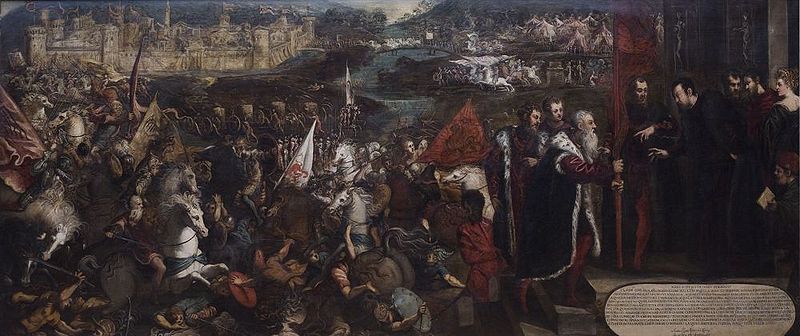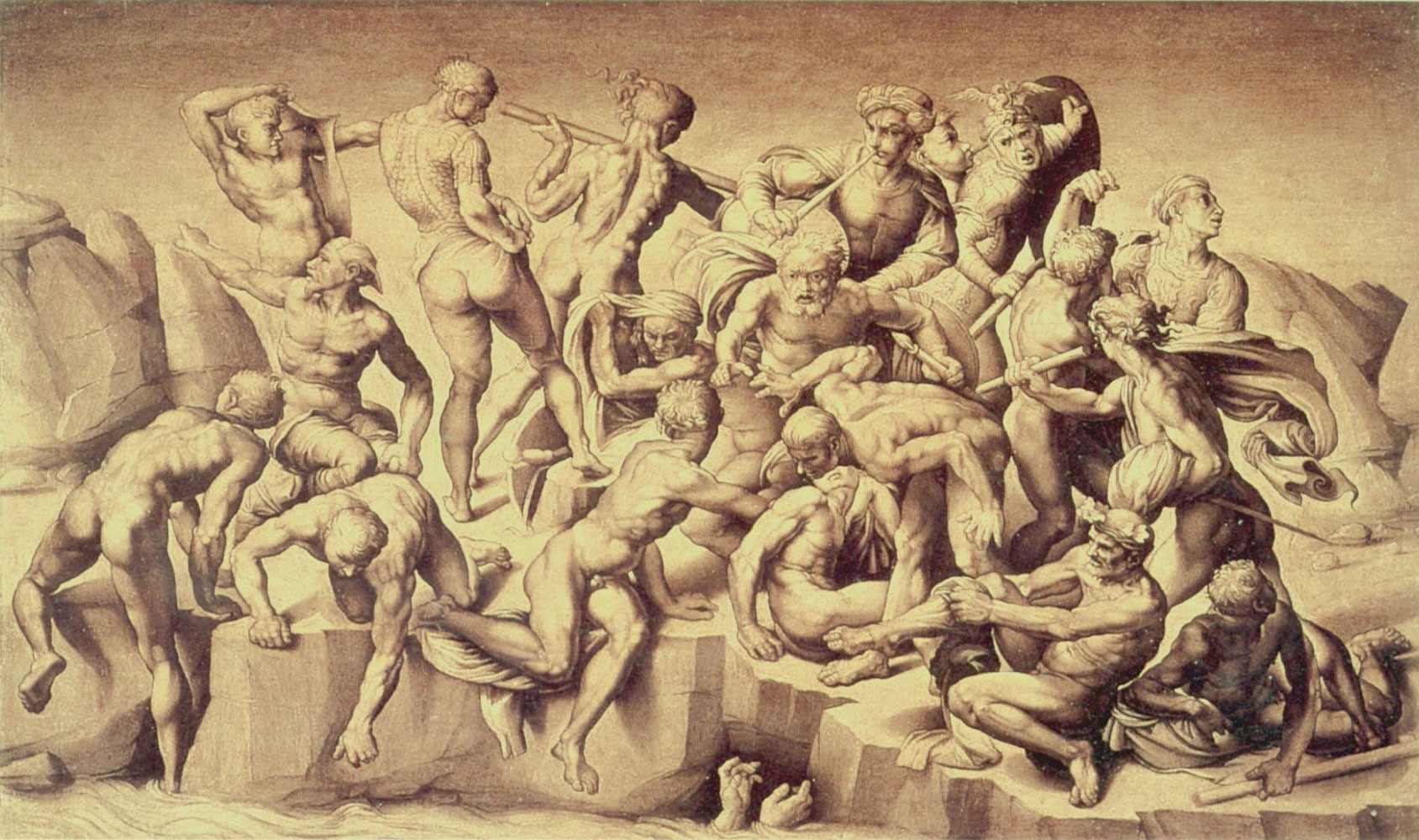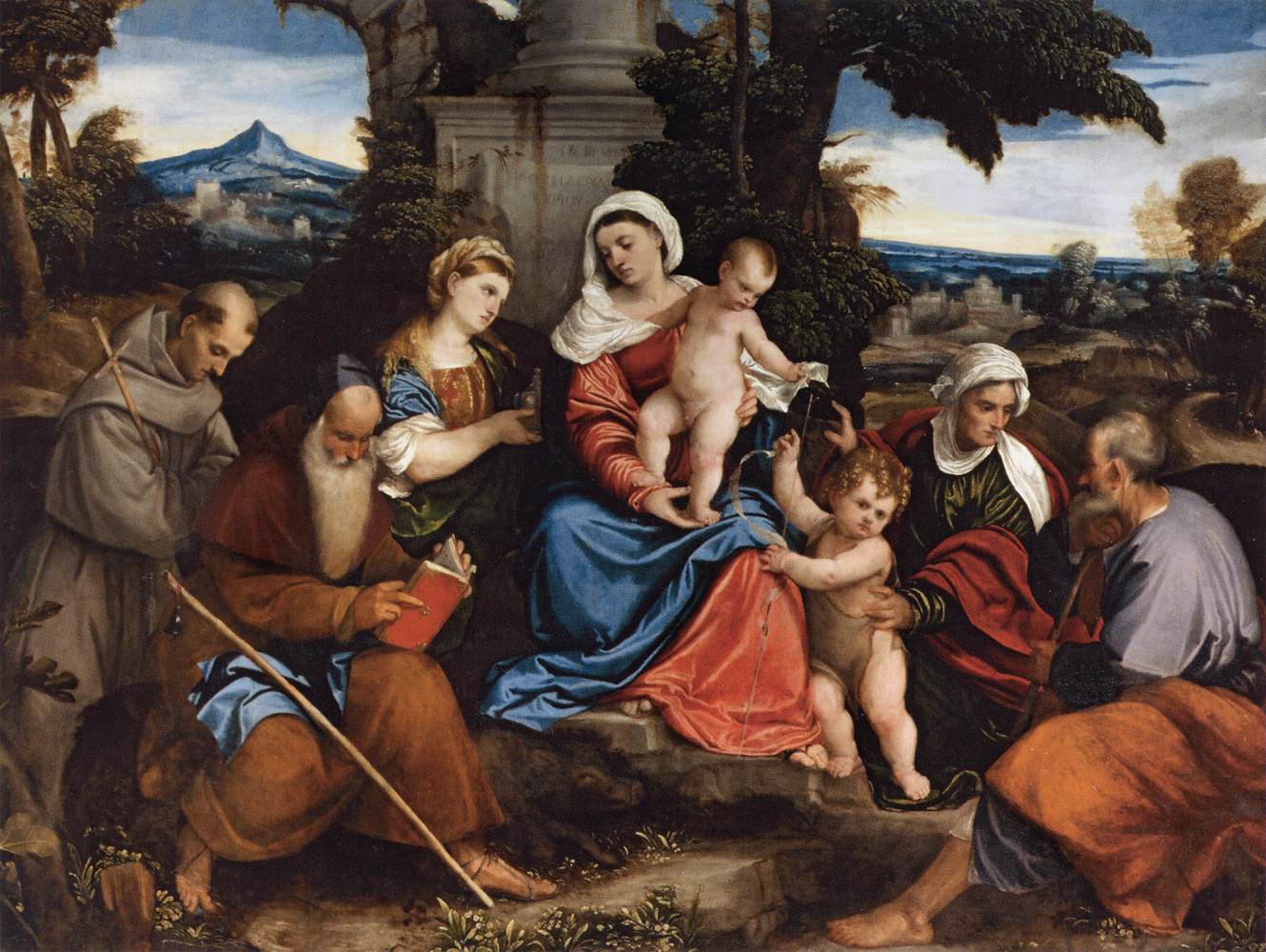|
Andrea Meldolla
Andrea Meldolla (), also known as Andrea Schiavone or Andrea lo Schiavone, literally "Andrew the Slav", (c. 1510/15–1563) was an Italian Renaissance painter and etcher, born in Dalmatia, in the Republic of Venice (present-day Croatia) to parents from Emilia-Romagna, active mainly in the city of Venice. His style combined Mannerist elements, a relative rarity in Venice, with much influence from the mainstream of Venetian painting, especially Titian. Biography Meldolla was born in the Venetian-ruled city of Zara in Dalmatia, now Zadar in Croatia, the son of a garrison commander of a post nearby. Both of his parents came from the small town of Meldola, close to the city of Forlì in Romagna. His father, Simon, had been employed as a constable in the Dalmatian city, and therefore moved there with his family from Romagna. The Meldolla family continued to own property in Romagna until the early 16th century. He trained either in Zara or in Venice. Gian Paolo Lomazzo stated, in a ... [...More Info...] [...Related Items...] OR: [Wikipedia] [Google] [Baidu] |
Schiavone 1
Schiavone (; feminine ''Schiavona'', plural ''Schiavoni'') is an Italian language, Italian ethnonym literally meaning "Slavs" in Old Venetian: originally, this term indicated origins in the lands of Dalmatia and Istria (in present-day Slovenia and Croatia), when under the rule of the Republic of Venice. Today it is an Italian surname. History The importance of Schiavoni's role in the Venetian Republic is best shown by the name of one of the main streets in Venice, Riva degli Schiavoni, just in front of the Doge Palace and San Marco Square. A number of artists who worked in Italy who were of Slavs, Slavic descent were nicknamed ''Schiavone'' by their origin: some famous examples, among others, are painters Giulio Clovio and Federico Bencovich. Schiavone was also a designation of the Oltremarini, a military unit of the same descent in the Venetian Navy. The basket-hilted sword schiavona was also named after the Schiavone. Surname In Italy, the surname Schiavone mostly occurs in t ... [...More Info...] [...Related Items...] OR: [Wikipedia] [Google] [Baidu] |
Italian Language
Italian (, , or , ) is a Romance language of the Indo-European language family. It evolved from the colloquial Latin of the Roman Empire. Italian is the least divergent language from Latin, together with Sardinian language, Sardinian. It is spoken by about 68 million people, including 64 million native speakers as of 2024. Italian is an official language in Languages of Italy, Italy, Languages of San Marino, San Marino, Languages of Switzerland, Switzerland (Ticino and the Grisons), and Languages of Vatican City, Vatican City; it has official Minority language, minority status in Minority languages of Croatia, Croatia, Slovene Istria, Romania, Bosnia and Herzegovina, and the municipalities of Santa Teresa, Espírito Santo, Santa Tereza, Encantado, Rio Grande do Sul, Encantado, and Venda Nova do Imigrante in Languages of Brazil#Language co-officialization, Brazil. Italian is also spoken by large Italian diaspora, immigrant and expatriate communities in the Americas and Austral ... [...More Info...] [...Related Items...] OR: [Wikipedia] [Google] [Baidu] |
Sydney Joseph Freedberg
Sydney Joseph Freedberg (November 11, 1914 – May 6, 1997) was an American art historian and curator, mainly of Italian Renaissance painting. Freedberg was born in Boston and attended the Boston Latin School. He graduated from Harvard College in 1939, and acquired a doctoral degree a year later. One of his mentors was Bernard Berenson. He taught Fine Arts at Harvard from 1954 to 1983. At the time of his retirement in 1983 he was the Arthur Kingsley Porter Professor of Fine Arts at Harvard. He became chief curator from 1983 to 1988 of the National Gallery of Art in Washington, DC upon retiring from Harvard. During the Second World War, Freedberg risked disciplinary action by refusing as a matter of conscience to work on intelligence about Rome. Later he would say that "I was worried that the information I might gather might be used in a military operation against that city", and thus lead to irreparable damage to works of art there. Despite his decision, he was made an Honorary Me ... [...More Info...] [...Related Items...] OR: [Wikipedia] [Google] [Baidu] |
Raphael
Raffaello Sanzio da Urbino (; March 28 or April 6, 1483April 6, 1520), now generally known in English as Raphael ( , ), was an Italian painter and architect of the High Renaissance. List of paintings by Raphael, His work is admired for its clarity of form, ease of composition, and visual achievement of the Platonism in the Renaissance, Neoplatonic ideal of human grandeur. Together with Leonardo da Vinci and Michelangelo, he forms the traditional trinity of great masters of that period. His father Giovanni Santi was court painter to the ruler of the small but highly cultured city of Urbino. He died when Raphael was eleven, and Raphael seems to have played a role in managing the family workshop from this point. He probably trained in the workshop of Pietro Perugino, and was described as a fully trained "master" by 1500. He worked in or for several cities in north Italy until in 1508 he moved to Rome at the invitation of Pope Julius II, to work on the Apostolic Palace at Vatican ... [...More Info...] [...Related Items...] OR: [Wikipedia] [Google] [Baidu] |
Jacopo Bassano
Jacopo Bassano (c. 1510 – 14 February 1592), known also as Jacopo dal Ponte, was an Italian painter who was born and died in Bassano del Grappa near Venice, and took the village as his surname. Having trained in the workshop of his father, Francesco the Elder, he painted mostly religious paintings, landscapes, and genre scenes. Indeed, he often treated biblical themes in the manner of rural genre scenes, representing peasants, animals, and the agrarian landscape with great accuity. Bassano's pictures were very popular in Venice and, eventually, throughout Europe. His four sons: Francesco Bassano the Younger, Giovanni Battista da Ponte, Leandro Bassano, and Girolamo da Ponte, also became artists and followed him closely in style and subject matter. Life Jacopo Bassano was born around 1510 in the town of Bassano del Grappa, located about 65 km from the city of Venice. His father, Francesco il Vecchio, was a locally successful painter who had established a family worksh ... [...More Info...] [...Related Items...] OR: [Wikipedia] [Google] [Baidu] |
Tintoretto
Jacopo Robusti (late September or early October 1518Bernari and de Vecchi 1970, p. 83.31 May 1594), best known as Tintoretto ( ; , ), was an Italian Renaissance painter of the Venetian school. His contemporaries both admired and criticized the speed with which he painted, and the unprecedented boldness of his brushwork. For his phenomenal energy in painting he was termed . His work is characterised by his muscular figures, dramatic gestures and bold use of perspective, in the Mannerist style. Life The years of apprenticeship Tintoretto was born in Venice in 1518. His father, Battista, was a dyer – in Italian and in Venetian; hence the son got the nickname of Tintoretto, "little dyer", or "dyer's boy". Tintoretto is known to have had at least one sibling, a brother named Domenico, although an unreliable 17th-century account says his siblings numbered 22. The family was believed to have originated from Brescia, in Lombardy, then part of the Republic of Venice. Older studi ... [...More Info...] [...Related Items...] OR: [Wikipedia] [Google] [Baidu] |
Mannerism
Mannerism is a style in European art that emerged in the later years of the Italian High Renaissance around 1520, spreading by about 1530 and lasting until about the end of the 16th century in Italy, when the Baroque style largely replaced it. Northern Mannerism continued into the early 17th century. Mannerism encompasses a variety of approaches influenced by, and reacting to, the harmonious ideals associated with artists such as Leonardo da Vinci, Raphael, Vasari, and early Michelangelo. Where High Renaissance art emphasizes proportion, balance, and ideal beauty, Mannerism exaggerates such qualities, often resulting in compositions that are asymmetrical or unnaturally elegant. Notable for its artificial (as opposed to naturalistic) qualities, this artistic style privileges compositional tension and instability rather than the balance and clarity of earlier Renaissance painting. Mannerism in literature and music is notable for its highly florid style and intellectual sophist ... [...More Info...] [...Related Items...] OR: [Wikipedia] [Google] [Baidu] |
Giorgio Vasari
Giorgio Vasari (30 July 1511 – 27 June 1574) was an Italian Renaissance painter, architect, art historian, and biographer who is best known for his work ''Lives of the Most Excellent Painters, Sculptors, and Architects'', considered the ideological foundation of Western art history, art-historical writing, and still much cited in modern biographies of the many Italian Renaissance artists he covers, including Leonardo da Vinci and Michelangelo, although he is now regarded as including many factual errors, especially when covering artists from before he was born. Vasari was a Mannerist painter who was highly regarded both as a painter and architect in his day but rather less so in later centuries. He was effectively what would now be called the minister of culture to the Medici court in Florence, and the ''Lives'' promoted, with enduring success, the idea of Florentine superiority in the visual arts. Vasari designed the ''Tomb of Michelangelo'', his hero, in the Santa Croce, Fl ... [...More Info...] [...Related Items...] OR: [Wikipedia] [Google] [Baidu] |
Bonifazio Veronese
Bonifazio Veronese, born Bonifazio de' Pitati (1487 – 19 October 1553), was a Venetian Renaissance painter who was active in the Venetian Republic. His work had an important influence on the younger generation of painters in Venice, particularly Andrea Schiavone and Jacopo Tintoretto.Thomas Nichols. "Pitati, Bonifazio de’." Grove Art Online. Oxford Art Online. Oxford University Press. Web. 28 Dec. 2016 Life The artist was born in Verona from which his family moved to Venice around 1505. Here, the young artist reputedly trained under Palma il Vecchio. He was initially a close follower of il Vecchio. He ran a large workshop in Venice, which could execute small devotional works as well as large painting projects. His early work also shows his knowledge of Giorgione and TitianPitati, ... [...More Info...] [...Related Items...] OR: [Wikipedia] [Google] [Baidu] |
Parmigianino
Girolamo Francesco Maria Mazzola (11 January 150324 August 1540), also known as Francesco Mazzola or, more commonly, as Parmigianino (, , ; "the little one from Parma"), was an Italian Mannerist painter and printmaker active in Florence, Rome, Bologna, and his native city of Parma. His work is characterized by a "refined sensuality" and often elongation of forms and includes '' Vision of Saint Jerome'' (1527) and the iconic if somewhat anomalous '' Madonna with the Long Neck'' (1534), and he remains the best known artist of the first generation whose whole careers fall into the Mannerist period. His prodigious and individual talent has always been recognised, but his career was disrupted by war, especially the Sack of Rome in 1527, three years after he moved there, and then ended by his death at 37. He produced outstanding drawings, and was one of the first Italian painters to experiment with printmaking himself. While his portable works have always been keenly collected and ... [...More Info...] [...Related Items...] OR: [Wikipedia] [Google] [Baidu] |
Gian Paolo Lomazzo
Gian Paolo Lomazzo (26 April 1538 – 27 January 1592; his first name is sometimes also given as "Giovan" or "Giovanni") was an Italians, Italian artist and writer on art. Praised as a painter, Lomazzo wrote about artistic practice and art theory after blindness compelled him to pursue a different professional path by 1571. Lomazzo's written works were especially influential to second generation Mannerism in Italian art and architecture. Early life Born to a family of some social status, Lomazzo appears to have received a better education than most painters. Early indications of his artistic abilities led to his studying with the little-known Giovan Battista della Cerva, Giovanni Battista della Cerva, an assistant of Gaudenzio Ferrari (whom Lomazzo appears to have regarded as his real master). Lomazzo’s autobiography, published with his ''Rime'' in 1587, indicates that he received a steady stream of commissions for murals and altarpieces, once he became an independent mast ... [...More Info...] [...Related Items...] OR: [Wikipedia] [Google] [Baidu] |
Constable
A constable is a person holding a particular office, most commonly in law enforcement. The office of constable can vary significantly in different jurisdictions. ''Constable'' is commonly the rank of an officer within a police service. Other people may be granted powers of a constable without holding this title. Etymology Etymologically, the word ''constable'' is a loan from Old French ''conestable'' (Modern French ''connétable''),p. 93b-283a, T. F. Hoad, ''The Concise Oxford Dictionary of English Etymology'' (Oxford University Press, 1993) itself from Late Latin ''comes stabuli'' ( attendant to the stables, literally 'count of the stable'), and originated from the Roman Empire; originally, the constable was the officer responsible for keeping the horses of a lord or monarch.p103, Bruce, Alistair, ''Keepers of the Kingdom'' (Cassell, 2002), [...More Info...] [...Related Items...] OR: [Wikipedia] [Google] [Baidu] |









